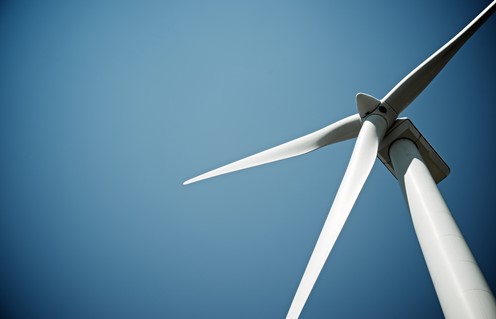 Add My Company
Add My Company

Wind energy is becoming an increasing priority in the United States' renewable energy landscape, delivering clean, sustainable electricity to millions of homes and businesses. With wind resources being utilised across coastlines, plains and mountain ranges, the US continues to embrace wind power to make a seamless energy transition.
The US is home to over 70,000 wind turbines, each helping the US work towards ambitious climate targets by reducing greenhouse gas emissions, improving air quality, and enhancing energy security. Beyond environmental benefits, the US wind industry also boosts economic growth, creating over 120,000 jobs in turbine manufacturing, maintenance, and operations.
Wind turbines not only reduce carbon emissions and are a cost-effective solution, they also offer an attractive alternative to fossil fuels. The deployment of thousands of turbines aligns with the government’s goals to cut greenhouse gas emissions below 2005 levels by 2030, and achieve a net-zero emissions economy by 2050.
With this in mind, BGB set out to uncover which states across the US are leading the charge in harnessing wind energy and which states may be falling behind. To do so, we analysed six key data points to evaluate turbine shortfall and overall wind energy efficiency across the country:
This includes:
- Number of turbines in each state
- Turbine output (kWh / month)
- Number of residential homes in each state
- Average energy demand per household (kWh per month)
- Monthly state-wide energy usage of residential homes (kWh)
- Number of turbines needed to meet residential demand
Revealed: Turbine shortfalls across the US
|
State |
No. of turbines |
Turbine output (kWh / month) |
Number of homes |
Average energy demand per household (kWh) |
Average energy usage of residential homes (kWh) |
Number of turbines needed to meet demand |
Turbine shortfall |
|
Iowa |
6,481 |
5,463,483,000 |
1,412,789 |
908 |
1,282,812,412 |
1,521.72 |
-4,959.28 |
|
Oklahoma |
5,527 |
4,659,261,000 |
1,746,807 |
1,142 |
1,994,853,594 |
2,366.37 |
-3,160.63 |
|
Texas |
19,137 |
16,132,491,000 |
11,589,315 |
1,174 |
13,605,855,810 |
16,139.81 |
-2,997.19 |
|
Kansas |
4,245 |
3,578,535,000 |
1,275,684 |
1,133 |
1,445,349,972 |
1,714.53 |
-2,530.47 |
|
North Dakota |
2,095 |
1,766,085,000 |
370,642 |
1,098 |
406,964,916 |
482.76 |
-1,612.24 |
|
New Mexico |
2,260 |
1,905,180,000 |
940,859 |
655 |
616,262,645 |
731.04 |
-1,528.96 |
|
Wyoming |
1,602 |
1,350,486,000 |
271,888 |
894 |
243,067,872 |
288.34 |
-1,313.66 |
|
South Dakota |
1,503 |
1,267,029,000 |
393,371 |
1,055 |
415,006,405 |
492.30 |
-1,010.70 |
|
Colorado |
2,907 |
2,450,601,000 |
2,491,403 |
723 |
1,801,284,369 |
2,136.75 |
-770.25 |
|
Nebraska |
1,504 |
1,267,872,000 |
844,275 |
1,034 |
872,980,350 |
1,035.56 |
-468.44 |
|
Montana |
979 |
825,297,000 |
514,799 |
860 |
442,727,140 |
525.18 |
-453.82 |
|
Minnesota |
2,733 |
2,303,919,000 |
2,485,558 |
817 |
2,030,700,886 |
2,408.90 |
-324.10 |
|
Oregon |
2,131 |
1,796,433,000 |
1,813,746 |
976 |
1,770,216,096 |
2,099.90 |
-31.10 |
|
Maine |
430 |
362,490,000 |
739,072 |
551 |
407,228,672 |
483.07 |
53.07 |
|
Alaska |
144 |
121,392,000 |
326,199 |
632 |
206,157,768 |
244.55 |
100.55 |
|
Vermont |
73 |
61,539,000 |
334,318 |
569 |
190,226,942 |
225.65 |
152.65 |
|
Hawaii |
128 |
107,904,000 |
561,065 |
632 |
354,593,080 |
420.63 |
292.63 |
|
District of Columbia |
0 |
0 |
350,365 |
720 |
252,262,800 |
299.24 |
299.24 |
|
Rhode Island |
35 |
29,505,000 |
483,468 |
602 |
291,047,736 |
345.25 |
310.25 |
|
Idaho |
598 |
504,114,000 |
751,858 |
1,055 |
793,210,190 |
940.94 |
342.94 |
|
New Hampshire |
84 |
70,812,000 |
638,799 |
629 |
401,804,571 |
476.64 |
392.64 |
|
Delaware |
1 |
843,000 |
448,736 |
944 |
423,606,784 |
502.50 |
501.50 |
|
West Virginia |
419 |
353,217,000 |
855,647 |
1,118 |
956,613,346 |
1,134.77 |
715.77 |
|
Utah |
208 |
175,344,000 |
1,151,414 |
798 |
918,828,372 |
1,089.95 |
881.95 |
|
Illinois |
3,719 |
3,135,117,000 |
5,426,429 |
755 |
4,096,953,895 |
4,859.97 |
1,140.97 |
|
Nevada |
68 |
57,324,000 |
1,281,017 |
924 |
1,183,659,708 |
1,404.10 |
1,336.10 |
|
Connecticut |
3 |
2,529,000 |
1,530,194 |
752 |
1,150,705,888 |
1,365.01 |
1,362.01 |
|
Puerto Rico |
63 |
53,109,000 |
1,598,159 |
900 |
1,438,343,100 |
1,706.22 |
1,643.22 |
|
Wisconsin |
480 |
404,640,000 |
2,727,726 |
703 |
1,917,591,378 |
2,274.72 |
1,794.72 |
|
Indiana |
1,651 |
1,391,793,000 |
2,923,176 |
1,005 |
2,937,791,880 |
3,484.93 |
1,833.93 |
|
Arkansas |
1 |
843,000 |
1,365,265 |
1,133 |
1,546,845,245 |
1,834.93 |
1,833.93 |
|
Mississippi |
59 |
49,737,000 |
1,319,942 |
1,220 |
1,610,329,240 |
1,910.24 |
1,851.24 |
|
Michigan |
1,715 |
1,445,745,000 |
4,570,170 |
665 |
3,039,163,050 |
3,605.18 |
1,890.18 |
|
Washington |
1,825 |
1,538,475,000 |
3,202,240 |
1,041 |
3,333,531,840 |
3,954.37 |
2,129.37 |
|
Massachusetts |
92 |
77,556,000 |
2,998,548 |
638 |
1,913,073,624 |
2,269.36 |
2,177.36 |
|
Missouri |
1,107 |
933,201,000 |
2,786,618 |
1,086 |
3,026,267,148 |
3,589.88 |
2,482.88 |
|
Kentucky |
1 |
843,000 |
1,994,315 |
1,154 |
2,301,439,510 |
2,730.06 |
2,729.06 |
|
Maryland |
80 |
67,440,000 |
2,530,846 |
1,031 |
2,609,302,226 |
3,095.26 |
3,015.26 |
|
New Jersey |
6 |
5,058,000 |
3,761,240 |
687 |
2,583,971,880 |
3,065.21 |
3,059.21 |
|
South Carolina |
0 |
0 |
2,344,965 |
1,124 |
2,635,740,660 |
3,126.62 |
3,126.62 |
|
Louisiana |
0 |
0 |
2,073,197 |
1,273 |
2,639,179,781 |
3,130.70 |
3,130.70 |
|
Alabama |
0 |
0 |
2,288,335 |
1,211 |
2,771,173,685 |
3,287.28 |
3,287.28 |
|
Arizona |
429 |
361,647,000 |
3,081,997 |
1,049 |
3,233,014,853 |
3,835.13 |
3,406.13 |
|
California |
5,509 |
4,644,087,000 |
14,392,140 |
557 |
8,016,421,980 |
9,509.40 |
4,000.40 |
|
Tennessee |
18 |
15,174,000 |
3,031,606 |
1,245 |
3,774,349,470 |
4,477.28 |
4,459.28 |
|
New York |
1,334 |
1,124,562,000 |
8,488,064 |
602 |
5,109,814,528 |
6,061.46 |
4,727.46 |
|
Virginia |
2 |
1,686,000 |
3,618,242 |
1,156 |
4,182,687,752 |
4,961.67 |
4,959.67 |
|
Ohio |
502 |
423,186,000 |
5,242,526 |
892 |
4,676,333,192 |
5,547.25 |
5,045.25 |
|
Pennsylvania |
766 |
645,738,000 |
5,742,837 |
857 |
4,921,611,309 |
5,838.21 |
5,072.21 |
|
Georgia |
0 |
0 |
4,410,953 |
1,088 |
4,799,116,864 |
5,692.90 |
5,692.90 |
|
North Carolina |
150 |
126,450,000 |
4,708,715 |
1,098 |
5,170,169,070 |
6,133.06 |
5,983.06 |
|
Florida |
0 |
0 |
9,865,356 |
1,078 |
10,634,853,768 |
12,615.48 |
12,615.48 |
With over 6,400 turbines, Iowa generates more than 1.54 billion kWh per month—more than enough to power the 1.4 million homes in the state. The data reveals that Iowa has a surplus of over 4,000 turbines, highlighting its increased level of efficiency in wind energy production.
Iowa’s natural environment may be helping as the state is a national leader in wind energy. With consistent and high wind speeds across its open plains, turbines can operate at peak capacity for longer periods, producing more electricity.
Joining Iowa in the top three states are Oklahoma and Texas. With mostly open geography and strong wind resources, Texas leads the US in the number of turbines, with 19,137 turbines generating over 4.23 billion kWh per month, meaning it could power all of its 11.5 million homes with just wind power alone. Similarly to Iowa, Oklahoma has 5,527 turbines but can still meet the electricity demands of all 1.7 million homes with a surplus of over 3,000 turbines, infrastructure which can be put to use providing energy for its growing industrial sector.
The differences across the states:
The amount of energy a household consumes varies across the US, influenced by factors such as climate, heating, and air conditioning needs.
For example, despite harsh winters and a regular deep freeze, average household energy demands in the state are just 632kWh per month. Despite this, Alaska does not currently have the necessary infrastructure to meet its residential energy demand by wind alone, needing 100 more turbines to meet demand.
Standing out at the bottom of the rankings is Florida. Despite being a state with a large population and high energy demands, Florida currently has no large wind turbines producing energy. Other power-hungry states such as Texas, Iowa and California have invested heavily in wind infrastructure.
Often called the "Sunshine State", Florida has prioritised solar energy as its primary renewable source, as it is likely the most cost-effective option for meeting the state’s energy needs. The state receives 255 days of sunshine a year, making it the perfect location for solar energy generation.
As well as having the most sunshine, Florida is known for its hurricanes. Extreme weather events can damage turbine infrastructure, leading to increased maintenance costs and potentially posing an investment risk.
While solar energy is a viable renewable option, relying solely on solar may have its limitations. Solar production is highly dependent on daylight hours, which can be inconsistent, especially in regions with heavy cloud cover or shorter winter days. Wind turbines can operate day and night, often producing more consistent output in areas with steady wind resources.
The future of wind turbines
Becoming an energy-efficient country is a priority for the US, and dedication to this goal can be seen as early as the 2000s when some of the first wind turbines were installed in Washington state. However, technology has come a long way, and ageing turbines often have lower efficiency compared to modern models.
Advances in technology over the past two decades mean newer turbines are taller, more powerful, and better equipped to capture wind energy efficiently. Many turbines across the US are nearing, or exceeding, their typical lifespan of 20–25 years, raising concerns about the reliability of ageing infrastructure. Typically, older turbines require more refurbishments and may produce less energy over time.
States with more modern turbines, like Oklahoma and parts of the Midwest, show recent investments and expansions in wind energy, reflecting the growing recognition of wind as a cost-effective and sustainable energy source.
Older turbines across the US may indicate a plateau in wind energy development or a shift in focus to other renewable energy sources. States without wind turbines may be missing out on an opportunity to diversify their energy mix, reduce grid strain, and provide a more reliable renewable energy supply to meet residential and industrial needs.
Knowing when to refurbish a wind turbine can be tricky, but keeping it running smoothly is essential. There are plenty of ways to make sure parts, like slip rings, can be replaced easily, ensuring turbines stay in top shape.
For more information please visit: https://www.bgbinnovation.com/products/wind-turbine-spare-parts.
ENDS
Methodology
Using official data from the United States Geological Survey, BGB created an index analysing six factors:
- Number of turbines in each state
- Turbine output (kWh / month)
- Number of residential homes in each state
- Average energy demand per household (kWh per month)
- Monthly state-wide energy usage of residential homes (kWh)
- Number of turbines needed to meet residential demand
For more information on The Power of Wind: How US States Are Harnessing Renewable Energy talk to BGB

